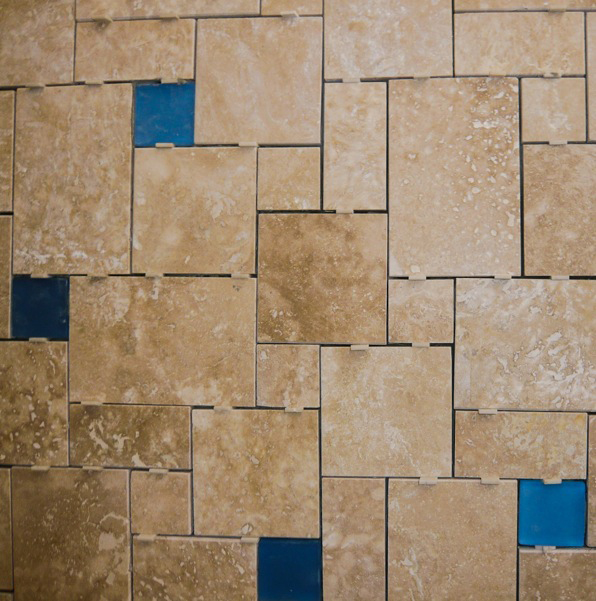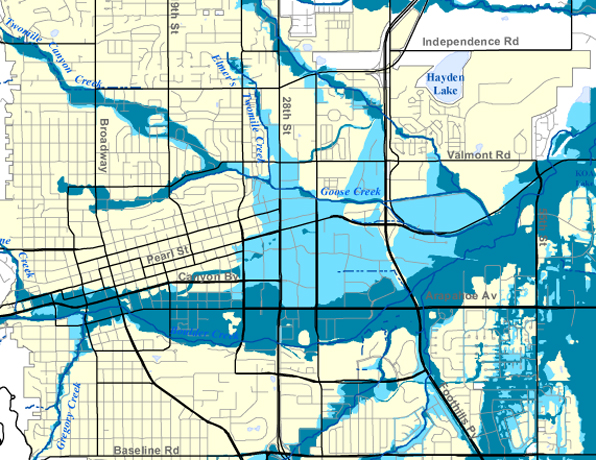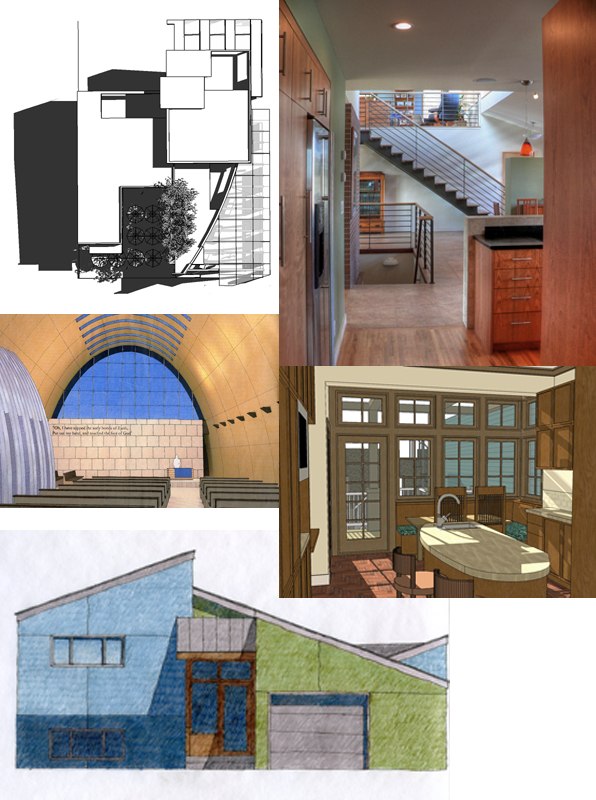It has been a very busy and productive number of months at M. Gerwing Architects and ACI and we have shamelessly neglected the blog in lieu of actually getting projects done. We have a number of projects that are nearing completion, including renovation projects in both North Boulder and South Boulder
South Boulder, construction progress
tile, pattern, geometry
As I have probably spoken about in previous posts, we draw no real distinction between architecture and interiors. They are all a part of crafting a series of spaces that are made of various materials that make up a building. To that extent, we spend as much time, and often considerably more, choosing interior materials.
Of particular pleasure for an architect may be the selection of tile materials, colors and patterns, as those selections are inherently tied up with geometry. Overall the selection of materials and colors in a space need to balance and most frequently this can result in creating fairly simple floor patterns with tile run in a conventional grid arrangement. However, I think it is a missed opportunity if we can not select a type of tile and a specific pattern of its installation that can reinforce the spatial and geometric ideas that are playing out in the rest of the space.
The photos here are all from a recent project of ours in Boulder, Colorado, that was almost entirely an interiors-only project. As a renovation of a conventional builder-type house, we avoided the costs of removing and changing a lot of interior walls by re-imagining the existing rooms and selecting materials and colors that would reinforce the nicer aspects of each space and draw one's attention away from the less-desirable parts. Floor tile patterns were crucial to this strategy and became a theme in the newly envisioned house.
I have written about my theory of the relative levels of abstraction of natural materials from their sources. More than consistent color or theme or pattern, I think this is the most intriguing way of creating harmony within a series of spaces without resorting to a slavish consistency or patronizing "style". Although the types and colors of the tiles used on the project were quite varied, they work together as a whole and are specific to each use and room to be functional and add to the overall feel of the house.
This project will conclude in the next few weeks and we will see the final results of the play of color and geometry to bring resolution to a house much in need of some character and order.
Colorado floods, North Boulder
after almost a week of unprecendented rains, flooding has surged all over the Front Range in Colorado. In a usually dry season, we have had more than 14 inches of rain in 2 days (that is about 2 years worth of rain here in the arid West).
Most Front Range communities sit on the edge of the fold where the relatively flat plains abruptly tilt up to start the Rocky Mountains. And, of course, these settlements founded themselves at water sources - snow-fed creeks that stream down from the mountains, gathering a reverse delta of little feeder streams, into a single, larger stream of river that spills out on to the plains. As we get very little rain out here, these streams are most active in May when the high mountain snow melt is most rapid. Little riverlets that are dry for most of the year swell to raging courses. As this happens every Spring and snow fall amounts don't vary all that much year to year, small flood plains or open areas surround these streams as they run through town. Once in a great while a particularly large snow melt will break the banks and cause some flooding and erosion.
The urban form that has built up around these little streams was in no way prepared for the onslaught of 14" of rain in September. Houses and businesses within a block or two of each of these water courses were overwhelmed with rapidly flowing mud and water. The debris flow was made worse by the recent wildfires, denuding the landscape and making topsoil up in the mountains even more fragile to erosion. The small branch that runs near my place is usually dry in September and the underpass is there more for pedestrian and bike access than to act as a floodway.
I write this as I am sitting in my office looking north, watching yet more rain soak the city. The worse is probably over according to the weather experts. The town is full of pickup trucks carting off soaked carpet and ruined furniture. The radio is announcing yet another flash flood warning for much of the Front Range.
Of course we can design buildings and landscapes to minimize the impacts of flooding. The City's website has always had very good information on the locations of flood prone areas - the 100-year flood zone, the conveyance zone, etc. But none of these maps imagined so much rain that flowed so quickly down every slope that even houses on the edge of mesas, far above flood zones, were heavily impacted by downhill debris flows and more water than sump pits and drain tile can handle.
So what to do next? Design for the worst-case? Certainly that should be the direction for the houses along isolated creeks and steep canyons west of town where the loss of life is at stake. But down here in the city, do we trade off some occasional water damage to basements against the chance of frequency of 100-year events?
I wrote some posts a couple of years ago about the risks of wildfire in the arid West. And now we are not so arid for at least a week or so. And the same topography that makes fires so dangerous - the steepness and remoteness of roads, the deep folds between peaks and valleys - creates as much threat for flood as fire.
We design houses to resist falling, burning embers drifting down from the sky. We design houses to resist storm-driven debris flows and water seeping up from below. We live in the fragile middle.
M. Gerwing Architects anniversary
M. Gerwing Architects has been in existence for six years as of April 1st. No foolin'. In that time we have executed a number of interesting projects, ones that benefited from that remarkable alchemy of open-minded clients, intriguing sites and managed budgets.
(Photos of projects by Boulder architect M. Gerwing Architects) Of course, along the way, like most practices, we have seen a few projects that did not get built. This is sometimes due to the vagaries of the national economy, sometimes a change of mind on the client's part, but most often it is evidence of never really finding the proper alignment of a property owner's goals and their budget. Nine times out of ten we can identify this within the first week or so of a project, but at times it is more elusive and only reveals itself further down the line.
So while I am proud of our achievements over the last six years, it is difficult for me to simply shake off the vision of the projects that might have been.
It is however in the nature of architects to look to the future. We are charged with imagining a thing-yet-to-be, a vision of not just a building, but the lives lived within it, the human drama that our buildings set the scene, draw out the landscape, create the stage for the action to ensue.















